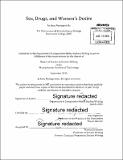| dc.contributor.advisor | Alan Lightman. | en_US |
| dc.contributor.author | Nowogrodzki, Anna (Anna Rose) | en_US |
| dc.contributor.other | Massachusetts Institute of Technology. Department of Comparative Media Studies. | en_US |
| dc.date.accessioned | 2016-02-29T15:02:51Z | |
| dc.date.available | 2016-02-29T15:02:51Z | |
| dc.date.issued | 2015 | en_US |
| dc.identifier.uri | http://hdl.handle.net/1721.1/101363 | |
| dc.description | Thesis: S.M., Massachusetts Institute of Technology, Department of Comparative Media Studies, September 2015. | en_US |
| dc.description | Cataloged from PDF version of thesis. "September 2015." | en_US |
| dc.description | Includes bibliographical references (pages 28-34). | en_US |
| dc.description.abstract | Low desire is the most common sexual dysfunction in women. Pharmaceuticals are being developed to treat it, most notably Flibanserin, owned by Sprout Pharmaceuticals. Sometimes inaccurately referred to as "female Viagra," Flibanserin actually treats an entirely different problem. Viagra allows men to get an erection, meaning that it treats physical arousal problems. Flibanserin, and other drugs for low sexual desire in women, act on the brain. Women with low desire don't have a problem with physical arousal or with orgasm, but with desiring sex before it starts. Most women with low sexual desire disorder have partners with higher desire than they do. So is low desire a medical, physiological problem in the brain? Or is it a sociocultural, interpersonal issue? Some experts think that the majority of women with what has been called a "disorder" of low sexual desire have no abnormal physiological problem, but instead are living in a sociocultural and medical system that encourages them to think of themselves as broken, and may be best treated with non-pharmaceutical methods. Other experts think that low desire is a physiological problem and drugs are important to treat it. Cultural shame around communicating about sex, undervaluing of women's sexuality compared to men's, and unrealistic sexual expectations all feed into and complicate the issue. | en_US |
| dc.description.statementofresponsibility | by Anna Nowogrodzki. | en_US |
| dc.format.extent | 34 pages | en_US |
| dc.language.iso | eng | en_US |
| dc.publisher | Massachusetts Institute of Technology | en_US |
| dc.rights | M.I.T. theses are protected by copyright. They may be viewed from this source for any purpose, but reproduction or distribution in any format is prohibited without written permission. See provided URL for inquiries about permission. | en_US |
| dc.rights.uri | http://dspace.mit.edu/handle/1721.1/7582 | en_US |
| dc.subject | Comparative Media Studies. | en_US |
| dc.title | Sex, drugs, and women's desire | en_US |
| dc.type | Thesis | en_US |
| dc.description.degree | S.M. | en_US |
| dc.contributor.department | Massachusetts Institute of Technology. Graduate Program in Science Writing | en_US |
| dc.identifier.oclc | 939625754 | en_US |
